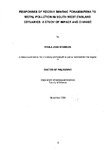RESPONSES OF RECENT BENTHIC FORAMINIFERA TO METAL POLLUTION IN SOUTH WEST ENGLAND ESTUARIES: A STUDY OF IMPACT AND CHANGE
| dc.contributor.author | STUBBLES, SHEILA JOAN | |
| dc.contributor.other | School of Geography, Earth and Environmental Sciences | en_US |
| dc.date.accessioned | 2013-10-10T08:53:10Z | |
| dc.date.available | 2013-10-10T08:53:10Z | |
| dc.date.issued | 1999 | |
| dc.identifier | NOT AVAILABLE | en_US |
| dc.identifier.uri | http://hdl.handle.net/10026.1/2134 | |
| dc.description | Merged with duplicate record 10026.1/793 on 15.03.2017 by CS (TIS) | |
| dc.description.abstract |
There was a major discharge into Restronguet Creek, south-west Cornwall in January 1992 of metalled acidic mine water drainage from the recently closed Wheal Jane tin mine. Shortly after this discharge a post-impact study using the responses of Recent benthic foraminifera as indicators of metal pollution was carried out on this Creek which had not been investigated previously. Because of a lack of pre-discharge foraminiferal data from Restronguet Creek, other estuaries, which previously drained metal mining regions, have been sampled in order to determine the background levels in foraminiferal populations. These estuaries, Fowey (Cornwall), Avon and Erme (south-west Devon) have not been investigated previously. The research programme included reconnaissance sampling of the estuaries Looe, Yealm, Kingsbridge, Axe and Carrick Roads (south-west England), primarilly to determine the geographical distribution of the agglutinated species. In all, 651 samples were taken for micropalaeontological and laser analysis from which an estimated 260,000 tests have been picked and some 70 species identified. A further 395 samples were taken for metal, carbon, nitrogen, sediment grain size and mineralogical analysis. The results of this research show changes over time with the colonisation of barren stations, increased abundance of living individuals, reduced proportions of deformed tests, less severe acid dissolution of the test walls and a seasonal species distribution which is similar to that of the Fowey Estuary. Low diversity is unchanged and the agglutinating foraminifera, which form distinct assembage zones in the control estuaries, remain absent from Restronguet Creek. The data provided by the short cores from Restronguet Creek suggest that the 1992 discharge does not account for the absence of these species. During the period of investigation the sediment-bound metals in terms of the concentrations have, in general, increased but the river water quality entering the Creek has improved in terms of metals and acidity. This suggests that the foraminifera are more directly influenced by metals in solution and that tangible benefits have been gained from the water quality improvement programme inaugurated by the Environment Agency. | en_US |
| dc.language.iso | en | en_US |
| dc.publisher | University of Plymouth | en_US |
| dc.title | RESPONSES OF RECENT BENTHIC FORAMINIFERA TO METAL POLLUTION IN SOUTH WEST ENGLAND ESTUARIES: A STUDY OF IMPACT AND CHANGE | en_US |
| dc.type | Thesis | |
| plymouth.version | Full version | en_US |
| dc.identifier.doi | http://dx.doi.org/10.24382/4300 | |
| dc.identifier.doi | http://dx.doi.org/10.24382/4300 |
Files in this item
This item appears in the following Collection(s)
-
01 Research Theses Main Collection
Research Theses Main


